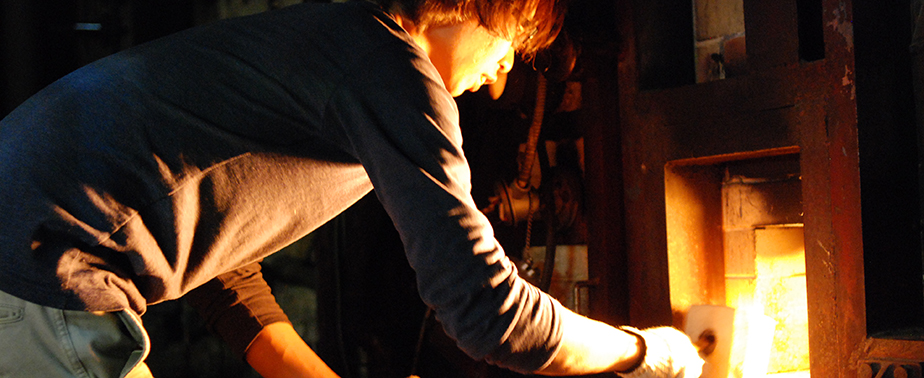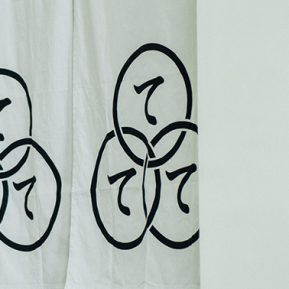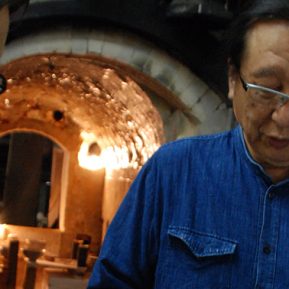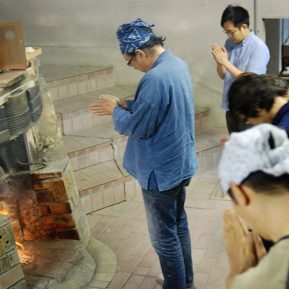Important in kiln firing is raising the temperature inside the kiln gradually and evenly. Depending on the color of the flame visible from the peephole and the degree of curvature in the Seger cone, a pair of people will load chopped pine from the left and right of the mouth of the kiln.
“Shall we do it?”
“All right.”
If the rhythm of the two loading chopped pine does not match, the flames will tend to one side Because the work is done with the kiln between the pair, making each other invisible, the pair call out and add the same amount of firewood. At 5- and 10-minute intervals… This work continues endlessly until the firing is finished.

In the corner of the workshop is a massive pile of chopped pine. All of the staff split the firewood and prepare right up until the firing begins. Firewood is a food for nobori kiln firings, which work with flames. The amount of chopped pine used in an Asahiyaki three-day firing is well over 10 tons.

Stoking the fire
In the middle of the night on the second day of the firing, Yusuke spoke to me as he watched the orange flames.
“If the kiln firing was an orchestra, my father would be the conductor. He lets his eyes shine on the inside of the kiln and gives detailed instructions as to the timing and amount of firewood to be added. And the artisans and I are the performers who do exactly as the conductor says. If my father says ‘three and a half logs,’ we quickly split them as needed. Not only does he look at the color of the flame visible from the kiln peephole, but he also references the sound of the flames.”
But they are not active every moment of the three days and nights. They create the stream of flames by changing between “quick firings” to quickly raise temperatures and “stoking the fire” to slowly adjust the heat inside the kiln.
During the kiln firing, they take turns taking naps, always with two people watching the kiln. Sometimes Hosai will come around and watch the kiln and give instructions.

The pottery workshop’s big day
Different from normal days, what is it Yusuke is thinking as he watches the kiln over these three days? “I’ve experienced this many times, but it’s always different. I see this kiln all year around, but strangely it feels bigger whenever we are firing. Even if I work my hardest to fire this kiln, there’s a chance every single piece out of a thousand could be bad. So, that anxiety doesn’t go away until I open the kiln. When I was little, I just really looked forward to firings. Everyone was somewhat restless. It felt like a festival. My family and the artisans would all eat curry in front of the kiln, and they would let me stay up a little later than usual. It might be different for children and adults, but it’s a big day for pottery workshops.”
Working to do right by our predecessors
Hosai sometimes paces around the kiln, deep in thought and watching the flames. “Once the firing starts, there isn’t much one can do, though. Not knowing when to give up, I’ll look inside any number of times, step away, and watch at the kiln. My father said that, ‘In the end, you don’t know until you open the kiln.’ I agree with that. But, I’m hesitant like this every time.” (Hosai)
Although they are always together, working in the same place, there is no time like a firing for father and son to grow closer. When I ask Hosai, “What advice do you have for Yusuke?” his response is simply, “Nothing in particular.”
“It’s been 10 years since my son came back. Since then, we’ve been together almost all of the time, so I’ve told him basically everything, you know? My father also liked to say, ‘In the end, you won’t know until you try it yourself,’ and said that the important things can only be learned from experience. This work seems like it is always the same, and yet it’s different every time. Everyone has to think of their own methods. But if I at least do right by our predecessors, my son will naturally learn to do the same. That’s how it is.” (Hosai)
It is almost time for the firing to finish. The number of times Hosai checks the flames has increased. He is trying to determine the final fire through the color, wavering, and sound of the flames.
“It’s difficult to put into words, but as my father said, ‘it feels like the fire sticks and climbs.’ A long time ago, I thought, ‘There’s no way it feels like that,’ but now I kind of understand what he meant. When the firing is done, that’s what the flames are like.” (Hosai)
The morning of the kiln opening
May 27. The morning of the kiln opening brings a mixture of hope and anxiety. Although the flames were put out yesterday and one day was spent cooling the kiln, when the shelves packed with pottery are removed, I feel a wave of heat pass over me.
Everyone is pale with lack of sleep, but their faces are bright. Yusuke and the artisans remove pieces from the kiln one after another, set them on shifting boards, and carry them off.

On the side, Hosai picks up the pieces one by one and looks at them carefully.
“This one is good”
“This one, too”
Hosai talks to no one; he is inspecting the new pottery. Did it go well? Or has the tension just dropped a level? His expression is a soft one, one I did not see during the firing. Besides him are his wife, Eiko, peeping at the pottery and their second son, Toshiyuki, beaming.


After all of the pieces have finally been lined up, Hosai responds to my asking about how the firing went with a simple, “It was okay.”
“There are some good pieces as well as some points of reflection this time around, too. All together, it was ‘Okay.’ There are always mistakes, but no regrets like, ‘I wish I hadn’t fired the kiln.’ This time was no different. Even when the yield rate is very low, there are always several pieces that I think, ‘This is good.’ That’s why I’m able to say, ‘I’ll do my best next time, too.’”


Hosai came close to me and whispered into my ear.
“I know I said it turned out ‘okay,’ but I meant it turned out ‘really well.’ For you, too.” With so many uncertainties, potters dislike the idea of “different from always,” no matter who they are. After exhausting human means, kiln firing is finished with the feeling of praying to the gods. Assuming that the outcome is bad can lead to saying things like, “I shouldn’t have done that.” I wonder if Hosai worried about me sitting there for the interview over the long firing. I will never forget his smile then, just ever so mischievous.

After this firing ended, Hosai’s condition grew progressively worse. This was my last day with Hosai.
(Continued)
SPECIAL
TEXT BY YUJI YONEHARA
PHOTOGRAPHS BY YUJI YONEHARA
16.12.23 FRI 21:13




